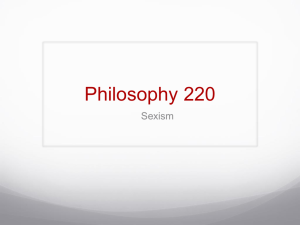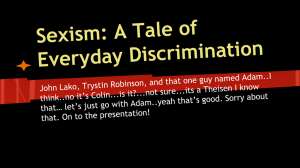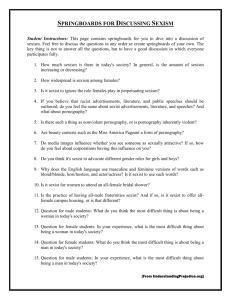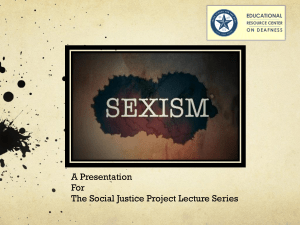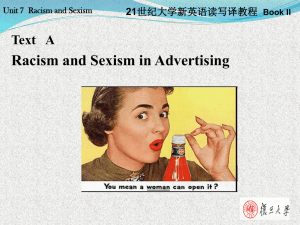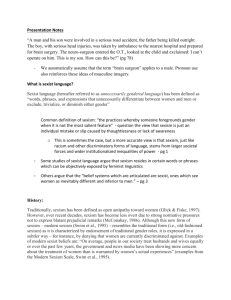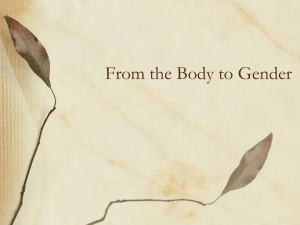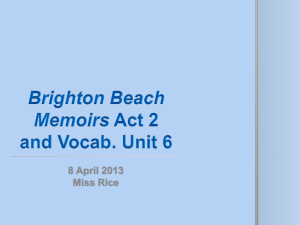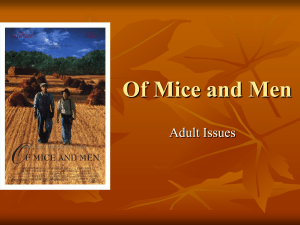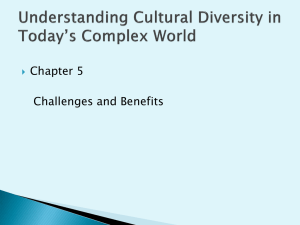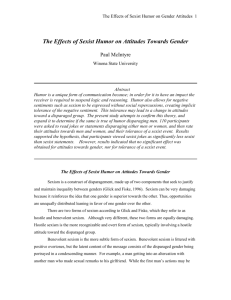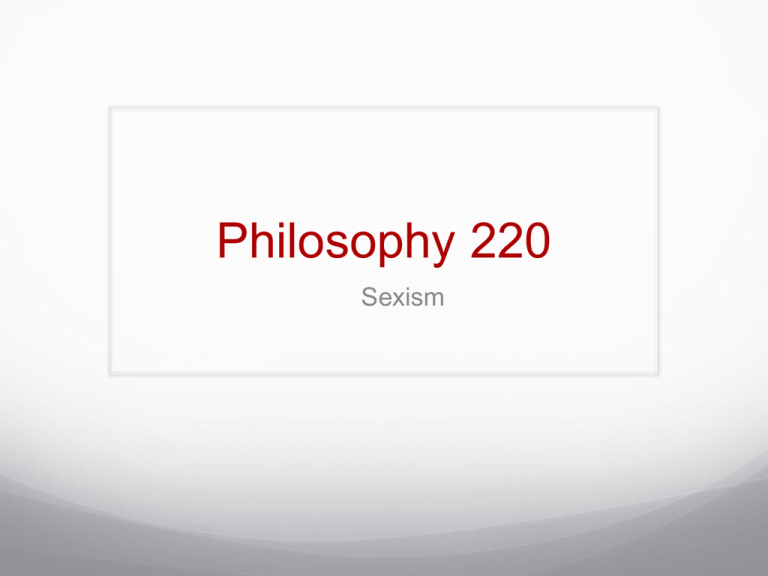
Philosophy 220
Sexism
Definitions
Sexism: 1. Prejudice or discrimination based on sex;
especially: discrimination against women. 2. Behaviors,
conditions, or attitudes that foster stereotypes of social
roles based on sex.
Prejudice: negative beliefs or attitudes about people
because of their race, sex, ethnic origin, etc.. Having
such beliefs makes a person a sexist or racist.
Discrimination: actions or practices directed against
individuals or groups on the basis of their race, sex,
ethnic origin, etc..
Intentional vs. Unintentional
Interpersonal vs. Institutional
Moral Theories?
Consequentialism: sexism is wrong
because of the negative consequences of
such beliefs and practices.
Kantianism: all persons regardless of
biological sex are deserving of equal
respect and thus sexism violates the
categorical imperative, as it treats people
as means rather than as ends in
themselves.
Frye on Sexism
Frye’s challenge is to provide an account of sexism
that captures what is (for her) its pervasive
character and has the capacity to convince the
skeptic.
Her approach is to start with the relatively noncontroversial claim that processes of sexidentification are ubiquitous and pervasive, and
then argue that as institutionalized in our culture,
these processes have the effect of systematically
privileging males.
Her focus then is primarily on institutional sexism.
Sex-Marking
Sex-Marking: the ways in which we respond to
members of a biological sex.
Example: Couple goes to a restaurant, waiter
addresses the man but not the woman
On Frye’s account, even the most innocent
appearing interaction between people is
heavily determined by marked sex-differences.
What about the handshake?
Sex-Announcement
Sex Announcement: the ways in which
we announce our sex to others
Example: Style of dress
Not only are these forms of determination
common but they are enforced to a
significant degree by social norms.
Small children; “Queen,” “Dyke.”
What Does it Mean?
Frye acknowledges that the pressure to mark and
announce our sex is equally present for men and
women.
However, she argues that the implications of this
pressure are markedly different for men and women.
“…one feature which never tends to his disadvantage…is his
maleness…one feature which always tends to her disadvantage is her
femaleness” (237c2).
Moving in the public sphere, dominant forms of
interaction, (marking and announcing) all, “…tend
systematically to the benefit of males and the detriment
of females” (238c2).
Subordination and Oppression
The systematic consequences of the differential
meaning of sex marking all tend, on Frye’s account
to accomplish the subordination of women.
That is the practical meaning of sexism:
oppression.
“…a system of interrelated barriers and forces which reduce,
immobilize and mold people who belong to a certain group, and effect
their subordination to another group…” (238c2).
Physical, material oppression is expensive; much
better to accomplish it by producing the
subordination as a system of cultural norms.
The Myth of the Natural
Many people who contest this point of view
point to “natural” differences between men
and women.
Frye doesn’t deny that there are biological
differences.
Rather, she argues that the differences
themselves do not explain or account for the
socialization around sex roles that we
experience.
Breaking Bad Habits
The first step towards reversing our
current situation is to look around and
notice that not everything is as clear and
certain as it appears.
When we notice this, we are in a position
to take on our own habits, struggling
against those which encourage and
enforce subordination and oppression.
Frye’s Definition of Sexism
“The term sexist characterizes cultural and
economic structures which create and enforce the
elaborate and rigid patterns of sex-marking and
sex-announcing which divide the species, along
lines of sex, into dominators and subordinates.
Individual acts and practices are sexist which
reinforce and support those structures, either as
cultural or as shapes taken on by the enculturated
animals. Resistance to sexism is that which
undermines those structures by social and political
action and by projects of reconstruction and
revision of ourselves” (241c2).
Garcia on Racism and Sexism
Garcia examines the common assumption that racism
is an appropriate model for understanding sexism.
While ultimately wanting to affirm this assumption, he
argues that most instances of this assumption, based
as they are on inadequate accounts of racism, provide
an inadequate account of sexism.
He supplies what he considers to be a better account of
racism, thus allowing a more adequate treatment of
sexism.
Limits of our Thinking about Racism
Most attempts to make the comparison in question rely
on an account of racism that fails to capture the
complexity of the phenomenon.
Things that go missing include:
1. Racist attitudes can persist in the absence of racist institutions or
ideology.
2. Racist institutions need not be systemic.
3. Racism does not require the concentration of power.
● As a result of problems like these, common accounts of
racism end up failing to encompass a whole range of
attitudes and behaviors that must count as racist.
What We Believe and How
If focus on oppressive practices doesn’t do the job,
what about focus on prejudiced beliefs?
This focus doesn’t seem to work either. It is easy to
come up with a couple of counter-examples:
1. Is a person who has a belief because they’ve been indoctrinated into it a
racist?
2. Can’t someone act in a racist fashion without holding associated beliefs?
Many theorists have responded by insisting that it’s not
just what you believe but how you believe it: as an
ideology resistant to criticism or in “bad faith.”
A New way of Thinking Racism
While Garcia does not think that this strategy is
successful, it does suggest an approach that he thinks
does the work necessary.
The key turns out to be not the racist’s beliefs nor the
social systems which they encourage but in her
“desires, hopes and goals.”
Racism, on this understanding is, “race-based ill will”
(245c2), a “commitment to opposing the advancement
of those whose race she makes her enemy” (Ibid.).
Advantages: 1) accounts for development from attitude to action; 2)
provides resources for better account of institutional racism; 3) cannot be
extended to counter-racist attitudes or institutions.
What is Sexism?
Given this account of racism as “race-based ill
will,” Garcia offers a definition of sexism as,
“…sex-based disregard or ill will” (247c1).
There are he suggests some important
advantages to this account.
1. Makes it explicit that sexism is opposition to women’s
interests.
2. Makes sexism obviously immoral.
3. Allows us to understand a particular form of sexism: sexist
paternalism.
Sexist Paternalism
Sexist paternalism occurs when it is argued that
special consideration or limitations of their behavior
is due women on the basis of their “special
situation.”
Like all paternalism, this type of justification of sexspecific treatment is vicious when, “…it is rooted in
disrespect, a failure to regard and to treat
members of one sex, as having the full rights and
status that it is one of the marks of the virtuous to
accord all people” (248c2).

